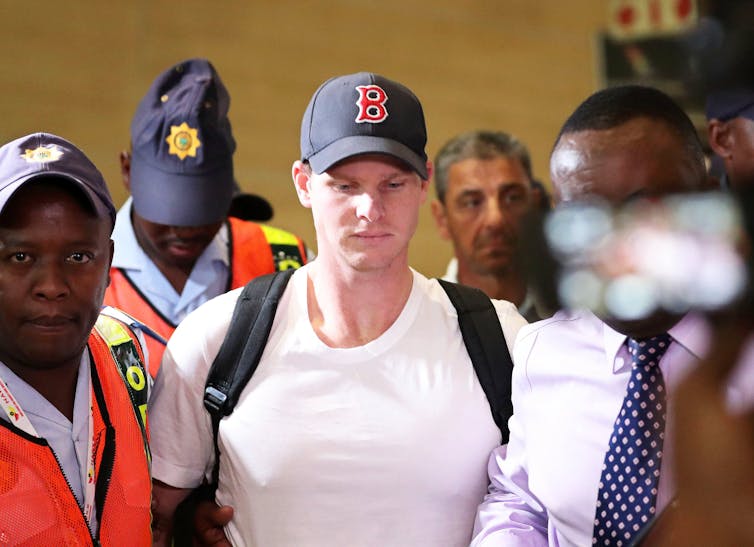
, and ,
Overnight, Cricket Australia handed out its for a ball-tampering incident that has engulfed the sport . Steve Smith and David Warner, the team’s captain and vice-captain, for 12 months. Cameron Bancroft, who carried out the failed plot, received a nine-month ban.
It was it was sandpaper, “yellow tape and the granules from the rough patches of the wicket” as originally claimed, that Bancroft tried to use to alter the ball’s condition in the Test match between South Africa and Australia.
While the International Cricket Council (ICC) initially suspended Smith for only one Test, all three are now banned from international and domestic (professional) cricket in Australia. Smith and Warner have also had their lucrative Indian Premier League contracts , and some sponsors from the players and . But these measures fall short of the some called for.
As captain, Smith has borne the brunt of the public and media vitriol, particularly as he accepted responsibility for what had happened. He may yet be Australian captain again in the future.
But according to Cricket Australia’s investigation, it was Warner who developed the plan and instructed Bancroft – a younger player – to carry it out. Warner also showed a “” and will therefore not be considered for any leadership position in the future.
Does the punishment fit the crime?
Ball tampering is clearly cheating; it breaks the rules and is against the “spirit of cricket”. But while it has been deemed the , there is a lack of consistency in how sanctions are dished out to offenders.
Read more:
Bans for doping violations are often severe. Players such as Andre Russell have been for failing to record their whereabouts for drug testing. But, historically, ICC bans for ball tampering have been more lenient: Pakistan’s Shahid Afridi for biting the ball in an attempt to alter its condition.
However, a harder line has been taken for incidents of match-fixing. Three Pakistan players were banned and jailed for a in 2010. South Africa’s Herschelle Gibbs in 2000 for agreeing to fix a match, even though he did not follow through with it.
Lifetime bans are not uncommon in sport generally. Ryan Tandy was for attempted spot-fixing in a rugby league game. Lance Armstrong from sanctioned Olympic sports for life and had his results voided for his serial doping in cycling. Even figure skating is not immune: Tonya Harding was for hindering the prosecution into a vicious attack on a fellow competitor.
It is difficult to compare sanctions across sports. But, when doing so, the inconsistencies are apparent. Boxer Mike Tyson was for biting off part of Evander Holyfield’s ear; footballer Luis Suarez for racially abusing an opponent; fellow footballer Paul Davis only for punching and breaking an opponent’s jaw.
In light of these punishments, are nine- and 12-month bans for premeditated cheating and lying reasonable and just?
Cricket Australia has been criticised for the time it took to reach a decision. But it’s essential that due diligence is done and facts are gathered before a sentence is handed down. Without this, decisions are made through the pressure of public shaming, and social media get to cast the final vote on the punishment.
If sporting organisations want players to act morally on field, then they too should be guided by moral behaviour in governing the sport.
Forgive and forget?
Society is often keen to forgive top athletes when they transgress. When athletes admit their mistakes and ask forgiveness it is usually granted.
Over time, sports fans also tend to forget athletes’ errors and focus solely on their on-field ability. In cricket, for instance, Don Bradman’s role in disputes over pay as a cricket administrator is . Shane Warne’s for a doping violation is rarely mentioned.
Drugs cheats (and sometimes welcomed) back into sport – some even after .
In many sports, athletes’ chequered pasts are ignored in favour of their on-field ability. It is often the actions that come as a result of their behaviour that are judged, and not the infringement itself.
Athletes frequently transgress, but their subsequent redemption is often woven into the narrative around them. Stories around sporting heroes , but the most recognised is the hero’s journey. The “hero” sets out on a quest but is faced by a crisis or descends into a hellish underworld. They “heroically” overcome these challenges and ultimately return to glory.
Read more:
![]() In this instance, Smith, Warner and Bancroft are in a hell of their own making. If they manage to return, and do so triumphantly, then it is likely they will be forgiven – and some may even forget their role in this sorry affair. Only time will tell whether they will again be considered heroic.
In this instance, Smith, Warner and Bancroft are in a hell of their own making. If they manage to return, and do so triumphantly, then it is likely they will be forgiven – and some may even forget their role in this sorry affair. Only time will tell whether they will again be considered heroic.
, Senior Lecturer in Sport Management, and , Senior Lecturer in Sports Psychology and Coaching Sciences,
This article was originally published on . Read the .



